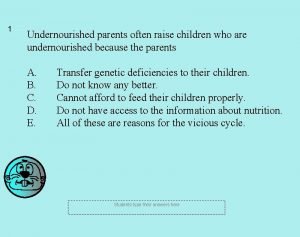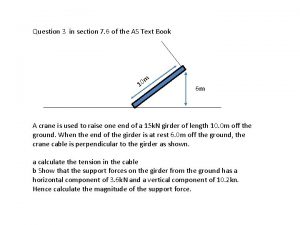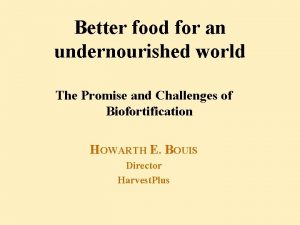1 Undernourished parents often raise children who are




















- Slides: 20

1 Undernourished parents often raise children who are undernourished because the parents A. B. C. D. E. Transfer genetic deficiencies to their children. Do not know any better. Cannot afford to feed their children properly. Do not have access to the information about nutrition. All of these are reasons for the vicious cycle. Students type their answers here

Food security has to do with 2 A. A country's dependence on cash crop exports. B. Preventing wars over diminishing food supplies. C. The ability of a population to obtain food on a day-to-day basis. D. The total volume of food a country imports. E. The total volume of aid a country receives. Students type their answers here

3 ____ percent of adult Americans are overweight. A. B. C. D. E. 23 40 80 64 90 Students type their answers here

4 Famines are most often serious when there is A. B. C. D. E. A very serious drought. No room to expand agriculture. Steady population growth. Armed conflict and political oppression. An attempt by indigenous people to return to old traditions and lands. Students type their answers here

5 Which of the following can drive up food costs? A. B. maize C. D. E. Futures markets Non-food end use of commodity crops, such as ethanol production from Exporting food for higher profits Floods, droughts, and storms All of these can cause increases in the price of food. Students type their answers here

6 People can suffer malnourishment if they consume large amounts of ______ instead of _______. A. B. C. D. E. Fat and sugar; vitamins and protein Proteins; carbohydrates Vitamins; protein Proteins and minerals; vitamins Fiber; processed foods Students type their answers here

7 Vitamin A deficiencies are associated with A. B. C. D. E. Anemia Weak bones A lack of energy, or listlessness Poorly developed neural systems in embryos Blindness Students type their answers here

8 What are two common diseases that result from protein deficiencies? A. B. C. D. E. Dysentery and diarrhea Dysentery and scurvy Scurvy and pellagra Goiter and cretinism Marasmus and kwashiorkor Students type their answers here

9 The three crops that humans rely on for the majority of nutrients and calories are A. B. C. D. E. Potatoes, wheat, and oats Wheat, rice, and maize Barley, oats, and rye Maize, oats, and rice Oats, beans, and barley Students type their answers here

10 Most of the livestock grown in North America are A. B. C. D. E. Confined in CAFOs. Held in pasture year-round. Kept in pastures during the day and barns at night. Kept in pastures during the summer and barns during the winter. Exported to Europe after slaughter. Students type their answers here

11 If fishing demands continue at the current rate, by which year will the world's major fisheries collapse? A. B. C. D. 2050 2075 2125 2100 Students type their answers here

12 A drawback of aquaculture in net pens is _______. A. increased feces and waste in localized shoreline area. B. increased disease transmission between the farmed fish and the native fish in the area. C. escape of exotic species into new ecosystems. D. All of these are correct. Students type their answers here

13 Increases in maize and soy production have led to _____. A. B. C. D. cheap ethanol fuel. an increase in healthy grain products at a reduced cost. an increased consumption of meat. the removal of government farm subsidy programs. Students type their answers here

14 Globally, how much of the produced cereals (grains) are fed to livestock? A. B. C. D. 1/3 1/2 1/4 1/10 Students type their answers here

15 An important role of the CRP is to A. B. C. D. E. Pay for research and development of irrigation systems for farmlands. Bring new land into production for agriculture. Regulate rotation of croplands. Pay farmers to take highly erodible land out of production. All of these are correct. Students type their answers here

16 High responder crops of the green revolution produce tremendous yields A. Even in severe drought conditions. B. With primitive farming techniques and no chemical use. C. In response to fertilizers, pesticides and irrigation. D. In all conditions where standard crops fail. E. Even in severe drought conditions and with primitive farming techniques and no chemical use.

17 Worldwide, traditional, and native varieties of food crops have _____ since the introduction of green revolution varieties. A. B. C. D. E. Become more widespread Stayed about the same in terms of use Been slightly influenced by new varieties Been widely replaced by new varieties Spread from region to region, leading to increased diversity Students type their answers here

18 Fifty years ago, there were several hundred varieties of wheat grown in the Middle East. Now a few of the more modern high responder varieties have replaced the indigenous species. What are the implications of this change? A. The productivity of wheat should continue to rise and increase the availability of food person. B. Genetic resources are diminished an epidemic of wheat disease is more likely due to the reliance on few species. C. The high responder varieties will need specialized harvesting methods because they are so productive. D. The biodiversity of wheat species has increased because of the introduction of few hybrid species. E. All of these are correct.

19 What percentage of processed food in the U. S. contains a GMO ingredient? A. B. C. D. 50% 60% 80% 0%, GMO's are outlawed in food.

20 The first genetically modified animal for human consumption is a salmon with extra growth hormones. Which of the following is NOT a concern about this animal? A. B. C. D. E. They will probably outcompete wild salmon for mates. Eating this fish will add extra hormones into our diet. They will probably outcompete wild salmon for food. They will probably outcompete wild salmon for habitat. These are all worries about the GM salmon. Students type their answers here
 Undernourished parents often raise
Undernourished parents often raise Antigentest åre
Antigentest åre Fiche frida kahlo
Fiche frida kahlo Frida kahlo grands-parents
Frida kahlo grands-parents Parents parents
Parents parents Literary present
Literary present Why are parents in oceania often afraid
Why are parents in oceania often afraid My parents kept me from children who were rough
My parents kept me from children who were rough My parents poem
My parents poem Children are made readers on the laps of their parents
Children are made readers on the laps of their parents Children obey your parents in the lord
Children obey your parents in the lord Children are made readers on the laps of their parents
Children are made readers on the laps of their parents Timothy winters
Timothy winters Often usually sometimes
Often usually sometimes Moral dimensions of information systems
Moral dimensions of information systems Is it time to raise pay achieve 3000
Is it time to raise pay achieve 3000 Let's go 1 unit 2
Let's go 1 unit 2 Troublesome verbs list
Troublesome verbs list Ali
Ali Living on the hallelujah side lyrics
Living on the hallelujah side lyrics A crane is used to raise one end of a 15 kn girder
A crane is used to raise one end of a 15 kn girder






































